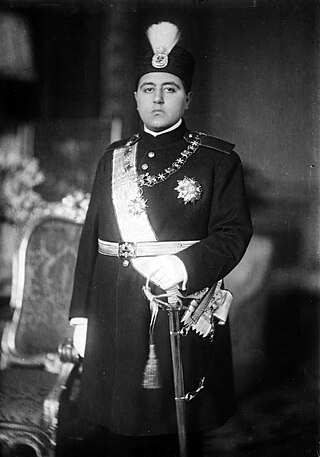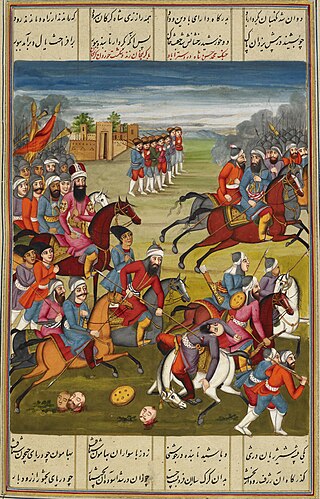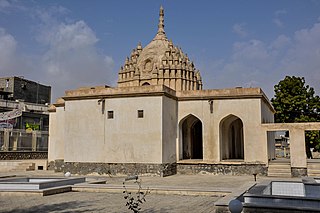
Mazandaran province is one of the 31 provinces of Iran, located along the southern coast of the Caspian Sea and in the adjacent Central Alborz mountain range, in central-northern part of the country. The province covers an area of 23,842 km2. It was founded in 1937.

Babol is a city in, and the capital of, the Central District of Babol County, Mazandaran province, Iran, and also serves as capital of the county. Babol is divided into two metropolitan areas.

The Golestan Palace, also transliterated as the Gulistan Palace and sometimes translated as the Rose Garden Palace from Persian language, was built in the 16th century, renovated in the 18th century and finally rebuilt in 1865. It is the former official royal Qajar complex in Tehran.

Qazvin ProvinceIPA:[ɢæzˈviːn] is one of the 31 provinces of Iran. It is in the northwest of the country, with the city of Qazvin as its capital. The province was created in 1993 out of part of Tehran province. At the time of the National Census of 2006, the population of the province was 1,127,734 in 294,305 households. The following census in 2011 counted 1,201,565 inhabitants living in 352,472 households, of whom 68.05% lived in cities and 31.95% in villages. By the time of the most recent census in 2016, the population had risen to 1,273,761 people in 397,165 households.

Ahmad Shah Qajar was Shah of Persia (Iran) from 16 July 1909 to 15 December 1925, and the last ruling member of the Qajar dynasty.

Agha Mohammad Khan Qajar, also known by his regnal name of Agha Mohammad Shah, was the founder of the Qajar dynasty of Iran, ruling from 1789 to 1797 as Shah. Originally a chieftain of the Quwanlu branch of the Qajar tribe, Agha Mohammad Khan was enthroned as the king of Iran in 1789, but was not officially crowned until March 1796, having deposed Lotf Ali Khan of the Zand dynasty in 1794. Agha Mohammad Khan Qajar was famously the eunuch Monarch, being castrated as a young adult upon his capture by Adel Shah Afshar, and hence was childless. He was assassinated on 17 June 1797, and was succeeded by his nephew, Fath-Ali Shah Qajar.

Amol is a city in, and the capital of, the Central District of Amol County, Mazandaran province, Iran, and also serves as capital of the county.

The Shāh Abdol-Azīm Shrine, also known as Shabdolazim, located in Rey, Iran, contains the tomb of ‘Abdul ‘Adhīm ibn ‘Abdillāh al-Hasanī. Shah Abdol Azim was a fifth generation descendant of Hasan ibn ‘Alī and a companion of Muhammad al-Taqī. He was entombed here after his death in the 9th century.

Mohammad-Ali Mirza Dowlatshah was a famous Iranian Prince of the Qajar dynasty. He is also the progenitor of the Dowlatshahi Family of Persia. He was born at Nava, in Mazandaran, a Caspian province in the north of Iran. He was the first son of Fath-Ali Shah, the second Qajar king of Persia, and Ziba Chehr Khanoum, a Georgian girl of the Tsikarashvili family. He was also the elder brother of Abbas Mirza. Dowlatshah was the governor of Fars at age 9, Qazvin and Gilan at age 11, Khuzestan and Lorestan at age 16, and Kermanshah at age 19.

An Iranian architect is traditionally called a mi'mar.

Amol County is in Mazandaran province, Iran. Its capital is the city of Amol.

Savadkuh County is in Mazandaran province, Iran. Its capital is the city of Pol-e Sefid.
Dibaj is a city in the Central District of Damghan County, Semnan province, Iran.

The Imam Reza shrine in Mashhad, Iran, is a complex which contains the mausoleum of Imam Reza, aka Ali al-Rida or Ali al-Ridha, the eighth Imam of Twelver Shias. It is the largest mosque in the world by area. Also contained within the complex are the Goharshad Mosque, a museum, a library, four seminaries, a cemetery, the Razavi University of Islamic Sciences, a dining hall for pilgrims, vast prayer halls, and other buildings.

Khudafarin Bridges or Khoda Afarin Bridges, are two arch bridges located at the border of Azerbaijan and Iran connecting the northern and southern banks of the Aras River.

The Shah Nematollah Vali Shrine is a historical complex, located in Mahan, Iran, which contains the mausoleum of Shah Nematollah Vali, the renowned Iranian mystic and poet. Shah Nematollah Vali died in 1431 aged over 100. In 1436 a shrine was erected in his honor and became a pilgrimage site; with the attention of successive rulers contributing various additions over the centuries.

Mohammad Hasan Khan Qajar, also spelled Muhammad and Hassan (1715–1759), chief of the Qoyunlu branch of the Qajar tribe of Turkomans in the Caspian coastlands around Astarabad, was the son of Fath Ali Khan and the father of Agha Mohammad Khan Qajar, who founded the Qajar dynasty of Iran.

The lord Vishnu Temple in Bandar Abbas, Iran is a historical monument constructed in 1310 AH during the reign of Mohammad Hassan Khan Sa'd-ol-Malek. The temple is dedicated to lord Vishnu.
Ali-Qoli Khan Qajar was a son of Mohammad Hasan Khan Qajar and half-brother of Agha Mohammad Khan Qajar, the founder of the Qajar dynasty of Iran. Unlike Agha Mohammad Khan's full brothers, Ali-Qoli Khan served loyally from the outset and supported, for around twenty years, Agha Mohammad Khan's conquest for control over all of Iran. Following Agha Mohammad Khan's assassination in 1797, he unsuccessfully tried to claim himself as his brother's rightful successor. Ali-Qoli Khan was eventually blinded and exiled by his nephew Baba Khan, who would ascend the Iranian throne as Fath-Ali Shah Qajar.


















